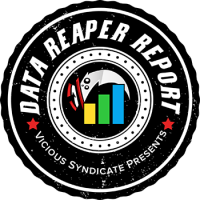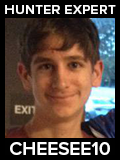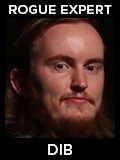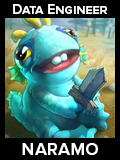Welcome to the 132nd edition of the Data Reaper Report! This is the first report following the Rise of the Mech buff patch.
Here’s a sponsored message from Sensor Tower:
Sensor Tower is hiring! Yes, our name is a Starcraft reference and yes, we love gaming and we work with top gaming and mobile publishers. Our co-founder was a Blizzcon Finalist for WoW Arenas back in the day, and we have a handful of legendary Hearthstone players including one pro-player. We’re always looking for people that are interested in providing insights for the mobile app and gaming industry. Contact our Recruitment Manager at [email protected] if interested in learning more. Here is a list of our jobs and more information about our engineering culture.

Our Data Reaper Project, including the Data Reaper Live has 4,800 active contributors and we thank them wholeheartedly. Contributing to the Data Reaper project through Track-o-Bot or Hearthstone Deck Tracker (recommended) allows us to perform our analyses and to issue the weekly reports. Without the community’s contribution, there would be no project. Contributing data is very easy and takes a few simple steps, after which no other action is required. If you enjoy our content and would like to make sure it remains consistent and free – Sign Up!
Quick Links
Class/Archetype Distribution | Class Frequency | Matchup Winrates | vS Power Rankings | vS Meta Score | Class Analysis & Decklists | Meta Breaker of the Week | How to Contribute | Credits
Number of Games
| Overall | 45,000 |
| Legend | 2,000 |
| Ranks 1-4 | 15,000 |
| Ranks 5-9 | 22,000 |
| Ranks 10-14 | 5,000 |
Class/Archetype Distribution
[TABS_PRO id=21134]
Class Frequency
[TABS_PRO id=21135]
Class Frequency Discussion
Hunter is the most popular class in the game following the Rise of the Mech buff patch. Its prevalence sits at around 25% at most levels of play. What’s slightly encouraging is that this gap is closed at legend, where 4 other classes are hot on its heels. Bomb Hunter is the dominant archetype for the class. It is, by far, the most common opponent you will meet on the ladder climb. It is followed by Midrange Hunter, Secret Hunter and a small number of Oblivitron Hunters, the much slower Mech Hunter variant built around Nine Lives and Mechanical Whelps.
Rogue has increased in popularity following the patch and diversified. Lackey Rogue has shattered into many different archetypes that are built around different cards. Lackey Rogues running Raiding Party are now called Party Rogue. We can also observe Hooktusk Rogue and the infamous Pogo Rogue. The most popular Rogue archetype is Shark Rogue, with the most common denominator of this variant being Spirit of the Shark. You will find out from this article that naming this archetype “Shark” Rogue is bathed in irony.
Warrior has declined in its numbers, with many players initially wary of taking the class to ladder due to the potential rise of several hard counters to Warrior as a result of the buff patch. Bomb Warrior is slightly more popular than Control Warrior, but this is flipped at legend, which is interesting to note. We’ll have to see whether there’s a reason why players at higher levels of play are leaning to Control Warrior over Bomb Warrior on ladder, since Bomb Warrior has usually been the stronger performer on ladder and tournaments over the past month or so.
Shaman is enjoying a huge spike in popularity as well as the emergence of new decks. While Murloc Shaman remains the most popular archetype of the class, Aggro Shaman is in the process of closing this gap, and potentially eclipsing the tribal deck if current trends continue. Doomhammer is back thanks to the Thunderhead buff, pushing an aggressive deck focused on Overload to the forefront of the meta for the first time since Tunnel Trogg, Totem Golem and Mean Streets of Gadgetzan.
But that’s not all for Shaman: we can see the emergence of a Mutate Shaman deck, pioneered by Jambre, which resembles the Evolve/Token Shaman deck from Journey to Un’Goro. This is truly a nostalgic time for Thrall. Slower Shaman decks, such as Control Shaman and Big Shaman, have been reduced to fairly low play rates.
After an initial decline in popularity, the Mage class is on the road to recovery, with its presence on an upward trajectory at higher levels of play. Luna’s Pocket Galaxy is making quite an impact on all three Mage archetypes: Cyclone Mage, Specters Mage and especially Freeze Mage, which has made a bit of a comeback after its disappearance before the balance changes.
Paladin has also spiked in play and is enjoying more attention. Mech Paladin has established itself as a fairly common meta deck following the Crystology buff. We’re also seeing Holy-Wrath Paladins attempting to capitalize on the same buff. While Paladin is still behind the top 5 classes in popularity, it has lifted itself out of the gutter, which is nice to see.
Token Druid stands amongst other common meta decks with similar play rates on the ladder climb, but its presence shrinks at higher levels of play. It is also finally shifting its build, with plenty of testing done with Mech builds in order to take advantage of SN1P-SN4P.
Similarly to Token Druid, Zoo Warlock is also attempting to incorporate a Mech package to varying degrees of success. Its presence is modest across all rank brackets.
While Priest sees a bit more play at lower ranks, it remains stuck at the bottom once you leave the Rank 5 floor. There isn’t a single Priest archetype with the play rate required to confidently assess, though we have an idea on how good Wall Priest, Miracle Priest, and the new Combo Mech Priest could be.
[TABS_PRO id=21136]

[TABS_PRO id=21137]
vS Meta Score
[TABS_PRO id=21138]
vS Power Rankings Discussion
In a young meta, it is very common to see discrepancies between true power levels and perception of power levels. We’re here, once again, to discuss the current meta dynamics, the observed discrepancies and provide explanations for them.
While Warrior has declined in popularity initially as a result of the patch, we can see that it is beginning to take over the game at higher levels of play. Once you reach legend, there is no stronger class than Warrior, with both Bomb Warrior and Control Warrior topping the charts. Whatever counters emerged do not come close to offsetting the benefits of a meta that’s pretty aggressive with new Warrior prey to feast on, such as Aggro Shaman. It is also benefitting from Valeera fooling around with bad cards, which we’ll talk about later.
Control Warrior’s popularity seems to line up with its current win rate, suggesting it is slightly stronger than Bomb Warrior once you reach rank 4. The explanation is fairly simple: the prevalence of aggressive decks makes it more beneficial to “turtle up” defensively rather than investing card slots into a plan of inevitability through bombs. Of course, the difference is very minor and could easily change with meta shifts. We could see Bomb Warrior overtake Control Warrior in the future, once the class grows in popularity and faces more hostility from the meta. The most important message is that Warrior is good no matter which deck you choose, and there are some nuances regarding what’s the better deck at any point in time, which can be seen in the decks’ matchup spreads.
We could write an entire article by itself when it comes Rogue’s current state, so we’ll bullet point the major insights about the class’ current performance:
“Shark” Rogue is a fairly good deck mired by some very sub-optimal card choices, which is hindering its current win rate. The biggest trap card in the deck is the very card it is supposedly “built-around”. Spirit of the Shark sucks. It sucked a month ago (and nearly everyone agreed it did), it sucked two weeks ago and it still sucks now. The buff patch did not change this. The balance changes did not change this. Spending 4 mana on a totem sucks. Praying you drew the right cards to make up for the fact you need to spend 4 mana on a totem sucks. It’s a trap that players at all levels of play have fallen into. This is not a borderline case of maybe’s. It’s a clear cut case that is resoundingly obvious. Lackey Rogue is fine. Spirit of the Shark sucks.
You’d think that based on Pogo Rogue’s 40% win rate, we would write off the archetype as garbage. We’ll surprise you: based on our observations, we think Pogo Rogue actually has the potential to be fairly competitive, but current ladder builds are very wide off the mark. The key to success with building Pogo Rogue correctly is removing “win more” cards such as Daring Escape and Spirit of the Shark (yes, Spirit of the Shark is not even good enough in Pogo Rogue!) in order to focus on cycling cards to maximize the efficiency of drawing Pogo-Hoppers. We talk about it in the Rogue section.
Here’s a shocking, gasp-inducing revelation: the best performing Rogue decks on ladder are the ones that do not add bad cards in order to make other bad cards work. Instead, they run genuinely strong build-around cards in Raiding Party and Captain Hooktusk. Party Rogue is a pretty strong deck even after the balance changes, and with some adjustments, we think it’s possible it will improve further. Hooktusk Rogue’s play rate is too low to confidently place in the table, but it’s clearly up there with Party Rogue on the right side of the 50% win rate mark.
Hunter is the most popular class, but judging by current meta trends, it might not stay the most influential class for long.
Bomb Hunter is the best deck in the game, until you hit rank 4. Then, it starts to decline in its performance quite substantially. As the most popular deck on ladder, it is being heavily targeted by the field. We can also see it performs gradually worse in many matchups at higher levels of play, suggesting a strikingly low skill ceiling. However, with an inevitable rise in Warriors coming, Bomb Hunter should remain a strong deck, which is currently evident in its jump back to Tier 1 at legend where Dr. Boom is more popular.
Midrange Hunter has fallen from its lofty heights. Several meta trends are negatively affecting its performance. The rise of Mech Paladin, even at its modest play rate, is extremely painful for Hunters since this matchup is so oppressive. The rise of Rogue is also proving to be a problem, while Aggro Shaman is exposing Hunter’s vulnerability to being smacked in the face with a weapon. Plus, Cyclone Mage (one of Hunter’s better matchups) is receiving less hype. Midrange Hunter is no longer an elite deck at higher levels of play, just a competitive one.
Secret Hunter continues to perform well at its modest play rate, despite not receiving much attention. It’s very well positioned against the Rogue class, which is why its performance shoots up at legend. It could very well become the strongest Hunter deck on ladder, but that depends on the balance between Warriors and Rogues going forward.
Nostalgia’s not the only thing Thrall has. The Shaman is back in elite company, joining Garrosh, his partner in memes, at Tier 1. Both Murloc Shaman and Aggro Shaman look very strong, with some differences between them. Aggro Shaman thrives in early game board battles, and Murloc Shaman has a stronger late game. This tends to give Aggro Shaman stronger matchups against early game decks, while Murloc Shaman performs better in longer games. However, there is a notable exception: Murloc Shaman performs better against Bomb Hunter. Aggro Shaman generally has fewer counters than Murloc Shaman and a “greener” matchup spread, but gets countered harder by Warrior. Control Warriors with Weapons Project and Harrison Jones are a nightmare for a Doomhammer deck.
Mutate Shaman can also be spotted, albeit in Tier 3. Its performance suggests it could be competitive, but the issue is redundancy: is there a good reason to play it over Aggro or Murloc Shaman? We’re skeptic, which is why it might fade away eventually, joining the company of Control and Big Shaman.
Cyclone Mage looks a little better than before the buff patch, sitting at a more solid position in Tier 2. Aggressive Shaman decks, as well as Zul’jin Hunters, provide it with the biggest challenges. However, Luna’s Pocket Galaxy is helping its matchups against Warrior, which is an encouraging sign for the archetype that has previously struggled to juggle its card choices to adapt to a changing meta.
We’re quite impressed with how Luna’s Pocket Galaxy performs in slower Mage decks, and we’re happy to see Freeze Mage return to the meta in some capacity, but we’re less enthusiastic about these decks in general. The problem with both Freeze Mage and Specters Mage is the Bomb Hunter matchup: it’s utterly miserable. As long as Bomb Hunter is as popular as it is, these archetypes’ win rates are unlikely to significantly improve.
Welcome the most polarizing deck in the game: Mech Paladin. This deck is showing a performance level that should keep it relevant going forward, but boy oh boy, is it a feast or famine deck. Mech Paladin eats Zul’jin Hunters and Warriors for breakfast, choking them out in spectacular fashion. On the other hand, the deck rolls over to Mages and Shamans in a similarly spectacular fashion. Success with Mech Paladin can certainly come and go depending on the meta, and it will be interesting to see whether the meta shifts in its favor. Considering the current performance of Warrior, Paladin players have room for optimism that there will be more prey to hunt.
Holy-Wrath Paladin is in a different situation. It just doesn’t have enough good matchups, which is why its win rate is fairly underwhelming. The Tier 1 decks of Shaman and Warrior are a big problem, and they’re not going away anytime soon.
Token Druid has gotten relatively weaker compared to two weeks ago because its well-rounded matchup spread has been smeared by a new red square: Aggro Shaman. It’s still a solid, reliable ladder climber with a win rate that suggests it will stick around. Zoo Warlock, however, continues to decline in its performance as you climb the ranks. It may struggle to find relevance in the current meta due to the presence of other aggressive decks that are just more efficient.
Is there any hope for Priest? There is, a little bit. Miracle Priest’s performance remains horrendous and it’s unlikely to make a comeback. Wall Priest is also extremely underwhelming, scraping the top of Tier 4 based on our estimate. It’s Mech Priest that looks fairly competitive, with a win rate that’s shy of the 50% mark. Anduin isn’t in the deep dumpster after all. With Mech Priest, we can finish our Priest quests instead of instantly re-rolling. Thank you, SN1P-SN4P.
Class Analysis & Decklists
Druid | Hunter | Mage | Paladin | Priest | Rogue | Shaman | Warlock | Warrior
Bomb Hunter is thriving following the balance changes. SNIP-SN4P has found its way into nearly every build and has become one of the strongest cards in the deck. The new neutral legendary fills a hole in the deck since Bomb Hunter previously struggled to decide on several underwhelming options for the final slot. The archetype is one of the better choices for the climb to legend, with only the Murloc Shaman matchup proving to be a common problem. Bomb Hunter players will continue to celebrate the heavy usage of Spirit of the Shark in Rogue, which is preventing the emergence of another potential counter.
Midrange Hunter was significantly hurt by the buff patch as a result of the rise of Mech Paladin, a crippling matchup that rivals Hunter’s struggle with pre-nerf Lackey Rogues. Mech Paladin pumps out more threats than the Hunter can ever manage to remove, and unless an exceptional Zul’jin turn is able to swing the game through Deadly Shots and Unleash the Beast, the game usually ends with Kangor’s Endless Army.
Secret Hunter continues to stay out of the limelight and continues to perform very well on ladder. It is the best performing Hunter deck against the Rogue class, at the cost of its Warrior matchups. Our last report’s tip of running Archmage Vargoth may have raised some eyebrows amongst you, but the card performs extremely well in the deck. History suggests we don’t just say things…
Another report means another extensive refinement analysis for Rogue. This class draws much of our attention due to the plethora of options available to it, including the bad options that flatter to deceive. Have we already mentioned that Spirit of the Shark sucks?
Anyway, let’s get down to the builds we’ve opted to feature and the rationale behind our choices.
Party Rogue is still a very strong deck with one big problem: the Warrior matchups. With the balance changes causing it to be a touch slower, Party Rogue is less likely to close the game before the Warrior stabilizes. This could emphasize the need for Party Rogue to have an alternative late game plan. Chef Nomi is currently not very popular in Party Rogue, but our estimate suggests his inclusion increases your Warrior matchup by nearly 10%. That comes at a cost of some of the faster matchups, of course, but as Warrior grows in popularity, this potential tech could become more enticing and worthy of consideration. If you don’t run into that many Warriors, swapping Nomi out for a 2nd Deadly Poison is the obvious adjustment you can make. However, keep in mind that without Nomi, Shadowsteps are worse and should also be removed (Hench-Clan Thug, Cable Rat, and Zilliax are some of the good options available to the deck).
Hooktusk Rogue is also very strong. Turns out that having a turn 8 battlecry that reads “win the game” is pretty useful in a meta in which other Rogue decks have slowed down. J_Alexander has been the most notable developer of the deck, incorporating a mech package alongside the pirate package. Nightmare Amalgam is a particularly great fit for this double tribal deck since it serves as both a Hooktusk target and a Zilliax/SN1P-SN4P target. What we can conclude based on the performance of Hooktusk Rogue is that Saps and Eviscerates are pretty important, while Leeroy isn’t as great in this build. Since we don’t rely much on burst and there are no natural bounce mechanics in the deck, he’s not as impactful.
Pogo Rogue performs like a dumpster Tier 4 deck, yet we see potential in the archetype to be competitive with the right approach. This approach is already showing promise amidst the more common garbage you meet on ladder. Pogo Rogue succeeds when it’s able to draw aggressively, which is why cycle cards such as Shiv and Fan of Knives are important. It’s more important to draw new Pogo-Hoppers rather than shuffle, buff or bounce them, which is why Spirit of the Shark, Youthful Brewmaster and Daring Escape are not good enough.
This build focuses more on tempo and having removal to fend off aggressive decks. We also run Vanish to provide us with a comeback mechanism, and just one Togwaggle’s Scheme to provide some redundancy with Lab Recruiters: you generally do not want to shuffle 10 bunnies into your deck and dilute your drawing power. This build is certainly not set in stone, and there are some things we’ll be interested to experiment with in the future. For example, running SI:7 Agent to fight earlier for the board, or running Heistbaron Togwaggle alongside Cable Rats to serve as another draw mechanism that’s versatile enough to act as a secondary win condition.
Finally, let’s talk about Shark Rogue. Just in case you missed it: Spirit of the Shark sucks. We’ve used our analysis of Shark Rogue to build a non-Shark Shark Rogue, and we’re very confident that this deck is a good performer. As we’ve said about Hooktusk Rogue, both Sap and Eviscerate are pretty good cards in the current meta and not running them will hurt you. This deck is also flexible enough to adjust to meta changes. If you’re running into Warriors, you can add MUE and Nomi as a late game package that will significantly improve your performance against them. Underbelly Fence would be the first card to cut since it shines in faster matchups. We’re not fans of Sea Giants, which are fairly common choices at the moment, since they’re horrendous against Warriors, which makes them unlikely to be particularly good in the near future.
Many players expected Warrior’s power level to drop as a result of the balance changes, followed by a buff patch that promotes several Warrior-choking strategies such as Mech Paladin. This did not happen. Warrior remains one of the strongest classes in the game thanks to a meta that introduced easy Warrior prey such as Shark Rogue and Aggro Shaman. Both Bomb Warrior and Control Warrior are thriving, and while there are some notable differences about the way they perform in specific matchups, it doesn’t change the fact that both are extremely strong choices for ladder play.
In terms of builds, SN1P-SN4P has proven to be very strong in both archetypes. It’s just a very versatile card that’s a great fit for any deck that runs a decent amount of mechs. With Warrior mirrors not being extremely common yet, Bomb Warrior can afford to drop Elysiana, but that could change depending on the extent of Warrior’s growth in popularity. Control Warrior has space for several techs directed at specific matchups, and they’re all very useful, especially Big Game Hunter and Ironbeak Owl against Mage and Hunter, respectively.
Shaman looks like a serious contender at the top of the meta, with the buffs it has received proving to be quite impactful. The change to Thunderhead has pushed an aggressive Overload Shaman deck to the forefront, while The Storm Bringer has become a more serious consideration for any Shaman deck that looks to flood the board.
Murloc Shaman is in a good place right now. It’s the only proven and reliable counter to the scourge of Bomb Hunters, and it also demolishes the rising Mech Paladins. The tribal build has taken over the archetype, while the Thunderhead package has found a home in a different archetype that’s more focused on burst damage. We really like how Hench-Clan Hogsteed is performing at the moment. This 2-drop is currently underplayed yet it is invaluable in every aggressive mirror.
Aggro Shaman with Doomhammer and Rockbiter has returned, bolstered by the health buff to Thunderhead which makes it extremely difficult to clear on turn 4. Thunderhead’s ability to take over the game and dominate board battles helps Aggro Shaman perform extremely well in aggressive mirrors, giving it an edge against both Murloc Shaman and Token Druid. The amount of burst damage it is capable of dishing out also gives it an edge against Midrange Hunter and Cyclone Mage, which are often a turn too slow to stabilize. Overall, Aggro Shaman is very well positioned, save for one major Kryptonite: Warrior.
There are a couple of insights we’ve found regarding Aggro Shaman builds, and they are especially pertinent to F2Pers. Both Zentimo and Electra Stormsurge are massively overrated. They are flashy cards that look really good when they work out, but ultimately aren’t very consistent due to their dependency on drawing other cards (not too different from a certain Shark-looking totem). Two Earth Shocks are essentially mandatory on ladder for two reasons: 1. Mech decks are everywhere, and silencing a magnetic buff is often game-winning 2. A Doomhammer deck needs to be able to bypass taunts easily to finish the game.
Mutate Shaman, a reminder of the Evolve/Token Shaman deck from Journey to Un’Goro, is another deck that has emerged from the buff patch and runs both Thunderhead and The Storm Bringer. Jambre, the creator of the deck, hit #5 legend with his build. Fen took the same list to #1 legend. This build looks to abuse Mutate tempo swings through Former Champ and Giggling Inventor while retaining a strong early game Thunderhead shell as well as a Swampqueen/Shudderwock late game package.
Luna’s Pocket Galaxy has created shockwaves through several Mage decks. The card has proven to be a worthwhile inclusion in the class, though its power level varies: It’s a decent card in Cyclone Mage, a very good card in Specters Mage, and a tremendous card in Freeze Mage.
Cyclone Mage has seen meta trends finally shifting in its favor, lifting it from its struggles before the patch. Galaxy’s inclusion has pushed the deck to become a bit more greedy. This has helped its Warrior matchup, but we question whether the increasingly popular Astromancers are actually worth it. Alexstrazsa, however, is a good closer in a Galaxy deck that happens to play giants.
Freeze Mage abuses Galaxy best. Much like every other Mage deck, it abuses Mountain Giant’s interaction with Conjurer’s calling but plays a more controlled game focused on stalling. SoLegit’s #3 legend build is the most popular version of the deck. Freeze Mage’s biggest problem on ladder is Bomb Hunter, which is a bit of a nightmare matchup. If you’re running into many Hunters, it might be worthwhile to consider cutting some greedier cards (Astromancer, Acolyte) for Arcane Keysmiths, which can help a lot in the matchup through Ice Barrier and Vaporize.
Specters Mage similarly struggles against Bomb Hunters and other aggressive decks. Apxvoid had the most notable success with the archetype, with a very greedy build that runs Barista Lynchen and Archmage Arugal, yet our issue with the original list are the Doomsayers. They are not actually good performers against the common aggressive decks on ladder (Earth Shock, Venomizer, Rogue things). We like adding Arcane Keysmith, a card that has consistently been performing well in every slower Mage deck we’ve seen over the past couple of months. This week is no exception, it’s just very underrated.
Is 1-mana Crystology as busted as we thought it would be? Why, yes. Yes, it is.
On the back of this over-tuned source of card draw, Paladin is showing signs of life. Mech Paladin, in particular, is proving to be a formidable ladder opponent and its rise in play, as modest as it may be, has affected several classes in a meaningful way.
What could prevent Mech Paladin from being extremely popular is its matchup polarity. It demolishes some of the top meta decks before the buff patch, most notably Bomb Warrior and Midrange Hunter. However, it has an absolutely miserable time against Shamans and Mages. The deck is definitely strong enough for successful ladder play, but you may want to be mindful of who your opponents are. The amount of tutoring this deck does is pretty incredible, but the biggest mystery to us is why no one is playing the ultimate tutor in Countess Ashmore. This deck wins when it draws Zilliax, so having more options to draw Zilliax while also increasing our chances of drawing SN1P-SN4P is something we can’t ignore. Based on how the few players who are utilizing Ashmore are doing, we recommend her. She’s pretty good.
Holy-Wrath Paladin has also benefitted from a 1-mana Crystology, but its performance on ladder is still not very impressive. Warriors and Shamans are major obstacles to consistent success with the deck on ladder, and its strong matchup against Cyclone Mage is not enough to offset them.
Much like other aggressive decks, Zoo Warlock is currently trying to figure out the extent to which it can abuse SN1P-SN4P, and whether or not the legendary justifies running a mech package in order to accommodate it.
The research we’ve done provides some interesting insights. We do consider SN1P-SN4P to be a very strong card in Zoo, but it needs some form of mech package to go alongside it. Thankfully, this small mech package has the potential to be quite strong but demands minimal disruption to Magic Carpet synergy while keeping Sea Giants in the deck. Sea Giants are very important in the current meta since they can instantly win aggressive mirrors, which tend to develop high-tension boards with multiple bodies (Bomb Hunters, Shamans, and Token Druids all tend to flood the board). Sea Giants also feed off of microbots, so they’re a natural fit for an aggressive mech deck. Since no one seems to have tried building a semi-mech Zoo deck that runs Sea Giants, we’ll do the honors and update you on how it performs next week.
Another interesting subject is Rafaam. With Warrior dropping in their numbers, for now, Rafaam no longer significantly improves Zoo’s performance on ladder to the point we opted to cut him in order to explore the mech path. However, that could change again should the Warrior class rise in popularity. We’ll warn you that publicly available stats related to Rafaam are misleading and susceptible to poor interpretation (regardless of technical failures).
Since Rafaam transforms your other cards, he affects their chances of being drawn (changing them to 0% chance of being drawn, a very extreme outcome). What ends up happening is that other cards will have inflated drawn win rates in the presence of Rafaam, since they’re less likely to be drawn in longer games where Rafaam is played and Zoo is more likely to lose. This makes Rafaam look comparatively worse to them. Evaluating Rafaam correctly requires more than looking at drawn win rates alone. This is true for every card that skews the chances of drawing another card, such that a draw is no longer a random occurrence. For example, Raiding Party and Master’s Call will inflate the performance of pirates and beasts in Party Rogue and Midrange Hunter. Therefore, always ask yourself whether drawing a card in a specific deck is a completely random occurrence, or whether there are mechanics that can change it.
Token Druid is in a decent spot. Much like before the buff patch, it’s a fairly stable deck with a well-rounded matchup spread that doesn’t have truly terrible matchups, making it fairly consistent on ladder.
You’d think things haven’t changed at all in terms of builds, and yet Token Druid is finally showing signs of moving away from the day 1 version we’ve theorycrafted on this website before Rise of Shadows even launched. The reason, of course, is SN1P-SN4P, which is a fantastic card in Token Druid, encouraging us to run a more sizeable mech package.
When we evaluate new builds of Token Druid in the new meta, we reach a very quick conclusion. Token Druid should no longer focus on winning through attrition with The Forest’s Aid and Soul of the Forest, but look to play faster with more immediate impact on the board. This helps the deck perform better in aggressive mirrors, while aiming to end games quicker in slower matchups.
A card that’s beginning to appear and shows great promise is Sea Giant. It synergizes with Wispering Woods as well as several mech token generators, but unlike Soul of the Forest, it can be cheated out and provide pressure immediately. This helps us blow out Shamans and Hunters when board tension is high, and heavily punishes Mages that usually do not answer your early board development. Try it out and you’ll notice the impact quite quickly.
Ladder has mostly abandoned the Priest class. It’s an extremely dire spot for Anduin, one which he’s fairly familiar with. Until Priest’s classic set weakness is addressed, it will continue to heavily rely on expansion cards for survival. If expansion cards don’t pan out, the class is very likely to bust out.
With that being said, perhaps Priest is not unplayable, since one archetype that has emerged after the buff patch is exhibiting some level of competitiveness. Matsup’s Mech Priest has been performing reasonably well on ladder. The mech package has several high health targets that synergize perfectly with the deck’s finishers (Divine Spirit/Inner Fire), while SN1P-SN4P adds another impactful threat to the deck. This deck feels a bit similar to Combo Priest decks of the past, though playing it will certainly make you miss Shadow Visions.
He’s suiting up, folks! The Mad Genius, Dr. Boom, is in the process of successfully taking over the meta. Be prepared to see him more often, as the field is full of decks that are easily picked apart by Warrior’s incredible removal kit. The rise of Warrior could bring more counters to the forefront, but even then, it’s unlikely that this class can truly crumble considering how flexible it is. We’ll have to wait and see. For now, there is no better class to play on the grueling climb to legend.
Our Data Reaper Project, including the Data Reaper Live has 4,800 active contributors. Without them, this project would not be possible, so we’d like to thank all of our contributors for their help.
Preparing our weekly article requires a significant amount of time and effort from many individuals. We would like to wholeheartedly thank our current Patreons, whose generous donations help us fund computing and server costs.
vS Gold is a new membership plan aimed to support our efforts towards improving our content and data analysis while receiving some bonuses and extra features.
Tier 3+ Patrons
Special thanks to Leo G, Aaron B, Jed M, Drew M, Alan J, Eric L, Zolstar, Sean H, Steve F, Andrew N, NObdy, Mark S, Alonso P, msKang, James Y, PinkMageDiaries, Je-ho, Adam P, Ziqiao Y, Stephen H, William H, and Mark P for supporting us for the month of June.
Contributors
Here are all the people that participated in bringing you this edition of the vS Data Reaper Report:































What are your thoughts on adding Lady in White to Mech Priest? The only card it genuinely affects negatively is Zilliax.
“Hooktusk Rogue’s play rate is too low to confidently place in the table, but it’s clearly up there with Party Rogue on the right side of the 50% win rate mark.”
Did you forget to add Hooktusk Rogue to the charts?
In terms of Combo Priest I’m not actually sold on Mecharoo and Sn1p-Sn4p. Both are consistently terrible off the top, and our strategy is centered around making big buffed up bois rather than lots of little dudes. Atm I’m running a list that cuts Sn1p-Sn4p for a second Mass Dispel (seriously, Cyclone Mage tears this deck apart), but have too little info about how good it is.